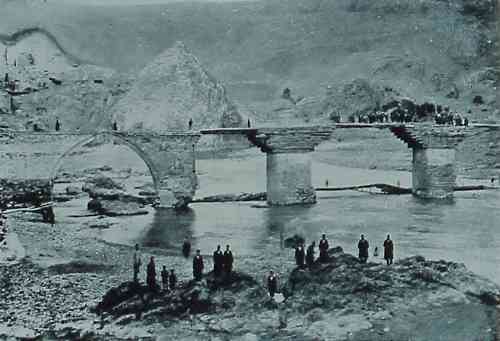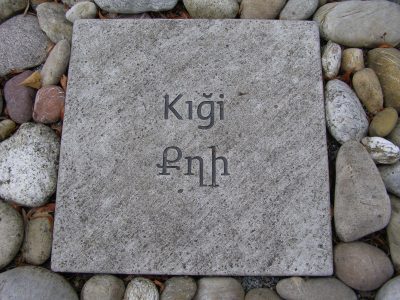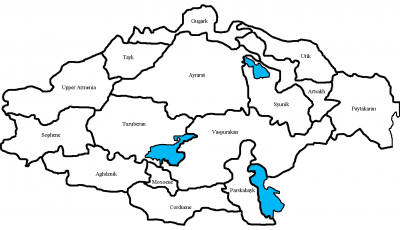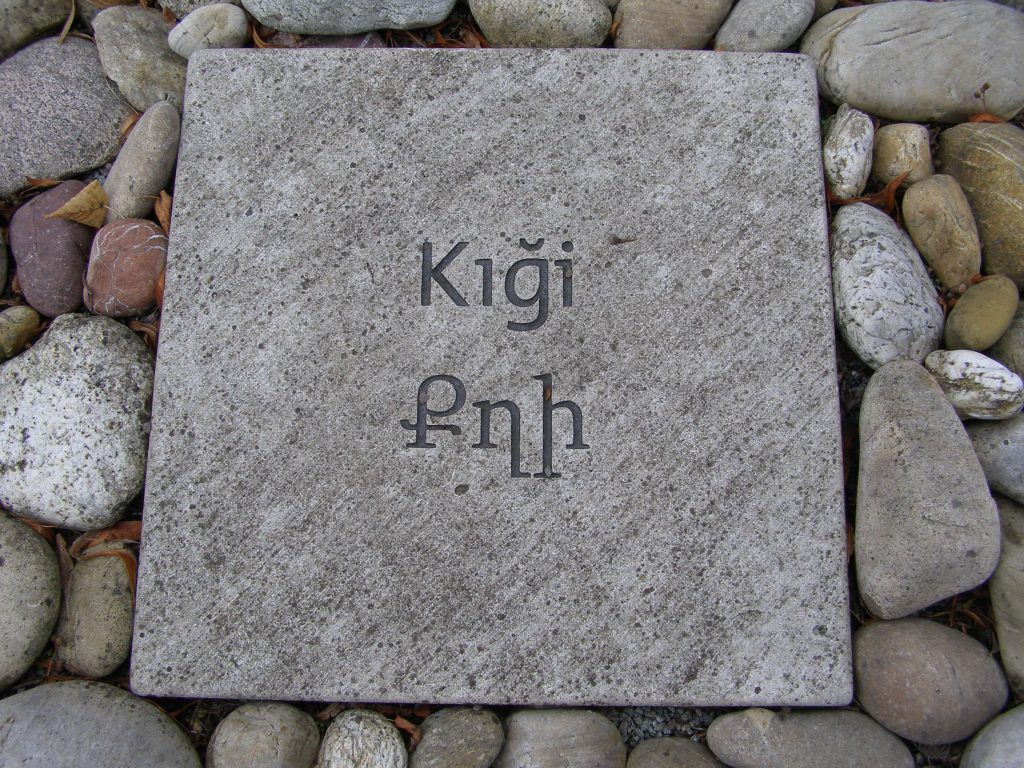
The kaza’s territory was very mountainous and forested at some places. In the western part is the highest mountain, called Surb Luys (‘Holy Light’) in Armenian, which reaches the borders of Dersim. The mountain is famous for its caves. The Kghi river, a tributary of the Eastern Euphrates (Armenian: Aradzan; Grk.: Arsanias, Trk.: Murat) flows through the kaza. Kiğı’s fauna was rich. Kiğı had mines of salt, lead, iron and clay.
Toponym
“The Kogi/Kigi castle, which was the center of the Khordjayk (Խորճայք; Xorzanênê in the Byzantine spelling) province of ancient Armenia, has been mentioned by name since the 6th century. The origin and meaning of the name are unknown. It is not Turkish, nor does it have an Armenian meaning.”[1]
Other varieties of the toponym: Geghi, Keghi, Keighi, Kezi, Kigh, Kighi, Kighi, Kghi-Gasapa, Kghi-Kasaba, Kyori
Population
In 1891, the kaza Kiğı had 41,225 inhabitants, of which 12,040 were Armenians. In 1909, 16,255 Armenians lived in 50 Armenian-populated villages.[2] On the eve of WW1, 19,859 Armenians lived in 51 localities of the kaza, maintaining 45 churches, five monasteries, and 63 schools with an enrolment of 2,925 students.[3]
In 1909 the Ottoman kaza Kiğı had 206 villages, 50 of which were inhabited by Armenians. The other villages were mostly inhabited by Kurds, followed by Turks and foreigners. Among the most populated Armenian villages were the following: Areg (Arek), Astghaberd, Darman, Khubs, Jermak, Hertif, Jipirgegh, Chan, Chanakhchi, Chumakh, Sagadzor, Seghank, Serkil and Osnak.[4]
The main occupations of the population were cattle breeding, agriculture, beekeeping and crafts. They were also engaged in leather making, pottery and masonry. Acorns, walnuts, pears and other fruits were collected from the forests.
Emigration was widespread in the kaza.
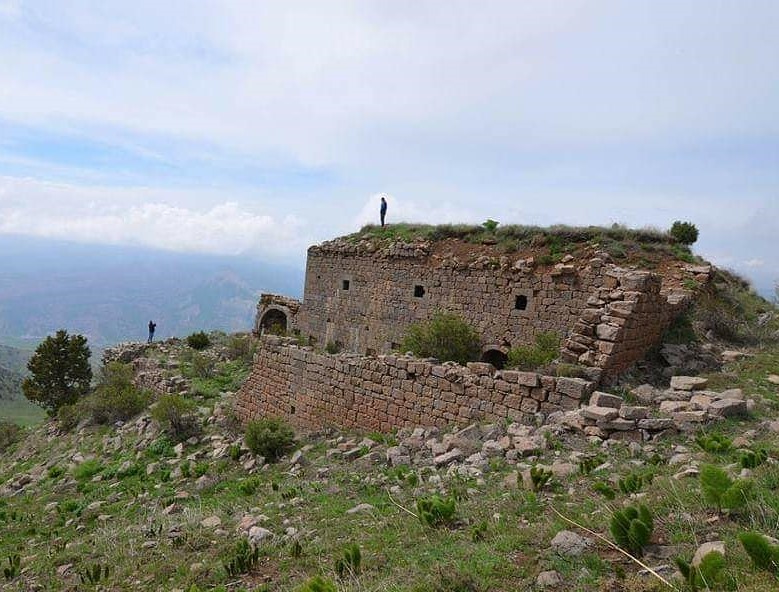
History
The territory of the kaza Kiğı corresponded to the ancient Khordzayk’ (Խորճայք) district of the Fourth Armenia of Armenia Maior.
This area was ruled by different Armenian, Byzantine, Kurdish and Turkic dynasties. The current location of the town was moved here after a Safavid raid in the 16th century, the old site was near the citadel. But the present structure is largely a restoration from later times. During the Middle Ages, Kiğı had been a mint town of the Ilkhanids. A nearby iron mine was exploited, but mining stopped in 17th century. There were battles in this area between the Russians and Ottomans during World War I.
The kaza Kiğı was rich in historical monuments. One of them is the fortress of Artales, which was fortified during the reign of Emperor Justinian I and became the seat of the Byzantine duke and a garrison. Two of the famous religious monuments are Surb Kirakos monastery near Astghaberd village, and the Surb Prkich (Holy Savior) monastery near the village Serkevil.
Destruction
As in the city of Erzurum, massacres in the kaza Kiğı started on 10 October 1895. Armenian-populated villages and Armenian churches were destroyed.[5]
The order to deport the 19,859 Armenian inhabitants of the kaza was made public on 8 June 1915. From 3 to 7 June, Armenian villages were searched by Special Organization bandits supervised by the sub-prefect, Laz Midhat Mehmed Bey, head of the local Special Organization branch. These operations, which were initially carried out in the villages of the district of Kiğı by the Special Organization result in some 1,500 victims. On 7 June, the villages of Khups/Çanakçı (1,216 individuals) resist the assault by a group of bandits.
The first convoy of deportees, made up of 1,200 people, left Kiğı on 11 June 1915, with their primate, Mgr Kegham Tivekelian. On 13 June the notables of the group, including the bishop, were separated from the convoy and shot near Tepe, at Deli Mizi on the Palu road. The other deportees were decimated a bit further south, in the middle of the Palu bridge on the Euphrates—another massacre site chosen by the Special Organization.
A second convoy of Armenians from the kaza of Kiğı made up of 2,000 villagers from fifteen localities in the western part of the district, 700 of whom are men, was dispatched on 11 June 1915. The convoy arrived in the surroundings of Palu, at Dabalu, on 15 June under the direction of Mehmedzade Hilmi, where the people in the convoy are decimated the same day by Special Organization thugs.
A third convoy, made up of the inhabitants of Kiğı and its surrounding villages, was dispatched on 12 June 1915. A group of deportees was killed by bladed weapons the following morning by thugs. The young women were abducted. Members of the escort disemboweled the women as they observed during the searches that some of them had swallowed their gold pieces. The escapees (around 15) rejoined at Palu on 16 June the remnants of the first two caravans, and together the group made their way south on the 18th day of the same month.
A fourth convoy (the last of the town of Kiğı), comprised of civil servants and merchants, was dispatched on 13 June directly to Harput under the command of the bandit chief Karaman Ulaszade Mustafa.[6]
“Of all deportees who had set out in the various convoys from Kiğı, some 3,000 arrived in Ras ul-Ayn. A month later, no more than 700 were left; famine and typhus had carried off the rest. Four hundred survivors were sent by rail to Hama and Homs and another 300 were sent to Der Zor. There, in late 1916, some 15 to 20 were still alive.
According to Vahan Postoyan, 1,500 people were killed in the villages before the deportation began, while 461 women und children were recovered from the Muslim population after Russian forces arrived in the region. The deportees were slaughtered in Chan/Çan (3,000), Tepe (2,500), at Palu Bridge (10,000), and in Kasrmaden, near Harput (13,000).”[7]
